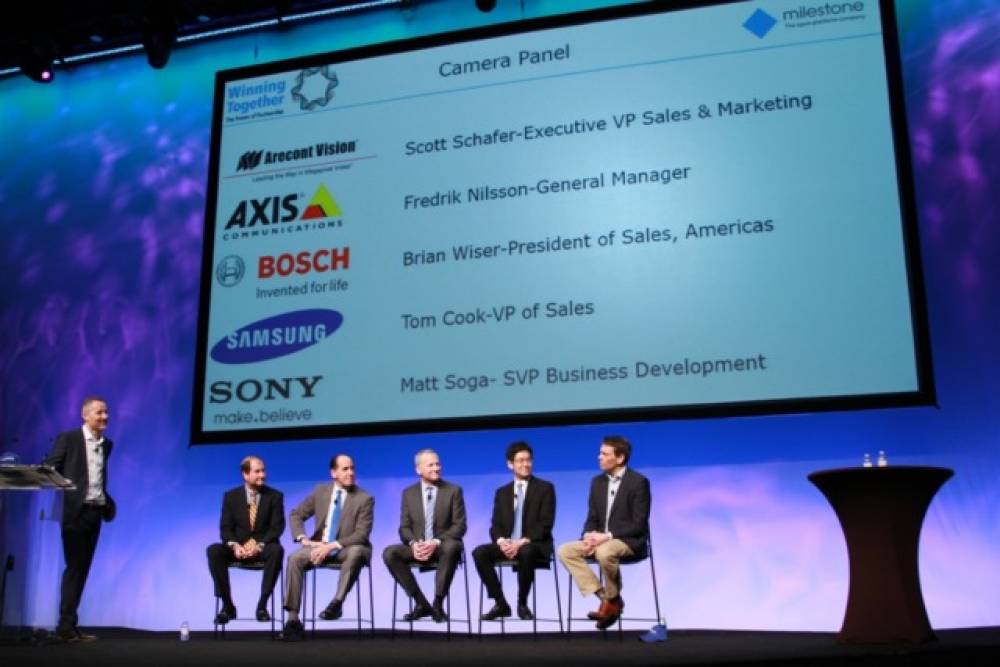The State of the Video Surveillance Industry (Security Info Watch)

View/download the original article published by SecurityInfoWatch here
Increased Price Pressure in the Market
When asked about increasing price pressures that are being driven largely by lower-cost manufacturers in Asia, Soga said that is an area of the market where Sony doesn’t really compete.
“We’re not a pricing leader and we can barely compete on the lower end side of solutions, so what we focus on is to keep developing solutions, offering products and working with our partners like Milestone to present end-to-end solutions to the customers,” explained Soga.
Cook, however, said that he disagreed with that philosophy and that companies shouldn’t just wave the white flag when it comes to supplying the lower end of the market with quality products.
“I think you’re giving up on an extremely large market that companies on the lower end are penetrating. We saw it Europe. They’ve been very successful and, honestly, our company is reacting to that,” added Cook. “Obviously, you have to create innovation, you have to have the upper echelon of products with 4K, larger megapixel and products we all feel will fit that market segment, but the other market segment is actually bigger.”
Soga countered that Sony is not “giving up” on the segment, but that there are areas where the company cannot offer a solution for as low of a cost as others.
Nilsson said that this also the result of being in a highly fragmented industry where the top 10 vendors make up less than 50 percent of the overall market.
“There will be consolidation and in any phase of consolidation all companies decide what position they want to have,” said Nilsson. “Do they compete on price? Do they compete on value or somewhere in the middle? Most manufacturers of reasonable size have similar costs in producing the cameras. China isn’t cheaper than any other market today and anyone of us up here could manufacture there today if we thought it was cheaper, but typically it isn’t, at least not nowadays. The cost is one thing, but the other thing you have at the price of a camera is quality and it’s basically on the software side. What’s the value of quality if you’re going to install a camera high up on a pole for seven years? Maybe it is relatively high. If you compete on price, you need to make sure you are the lowest one because there will be another company that comes in a little lower and then another that will come in a little bit lower, so it is kind of difficult to hold that position unless you really compete on price and nothing but price.”
“Companies like ours; we try to anticipate those kinds of from a technology bent, but also from an end-user solution bent, trying to figure out what those next solutions will be. We can guess what those are like we did with using CMOS sensors before people did and using H.264 as a platform - those kinds of things that are now commonplace were not commonplace 10 years ago,” said Schafer.
Helping End Users Make the Migration to IP
While the security industry is moving increasingly to IP technology, there remains a large existing install base of analog solutions. Even though his company still designs and promotes analog products, Cook said that IP is the future but that manufacturers need to work on improving the ease of use of network video.
“The one thing we’ve always recognized is with an analog camera, you plug it in and it pops up on a monitor. You plug an IP camera in, the tech sits there and looks at a monitor that’s blank and that’s the distinctive difference when you’re out in the field,” said Cook. “As much as we want to promote IP, the difference, how good it is and all of the feature sets, it still comes down to ease of use.”
Wiser said he believes that moving the market more towards IP is about establishing a migration path for end-users.
Nilsson said the argument against making the switch to IP is essentially the same as it was 10 years ago, which is that it is cheaper. However, network video still provides greater image quality, scalability and better overall total cost of ownership.
“You need to have a sales team that can sell that value,” added Nilsson.
Schafer also said that the poorer image quality provided by analog cameras should also provide more of an impetus for end-users to make the transition.
“If you’re going to make the investment, make it in the right way. Start with at least 720p or 1080p in that vein and move your way up because the economics are so much better,” he said. “The other side is that (IP) has allowed us to do things that we couldn’t do before.”
Impact of Camera Vendors Owning VMS Companies
Nilsson said that the trend of camera manufacturers buying video software firms is another sign of increased consolidation of the market.
Wiser said that while Bosch has offered its own VMS solution with much success in some applications, one of their focuses in on providing choice to its customers.
“For us, we are not necessarily pushing one (VMS) over the other. We are asking the customer, trying to understand their needs and trying to work with them to figure out what solution is best for them,” he said.
Soga said it also serves Sony better to work with video software partners to be able to appeal to the wider security market because some VMS systems may be stronger within certain verticals than others.
“In the end, that is a benefit for the customers,” said Soga.
Cook feels that companies can’t straddle both sides of the fence on this issue and either need to be an open platform or a complete system provider.
“It’s not just about your integrator; it’s more about your partners and sales team. Think about it, if a Milestone guy tomorrow in New Jersey says, ‘I’ve got a great opportunity, I need a camera partner.’ Does he pick a camera partner that has a competing VMS or does he pick a camera partner that has a manufacturer rep that has a competing VMS?” asked Cook. “Subconsciously, I’ve got a great opportunity. Do I want to risk that?”
















